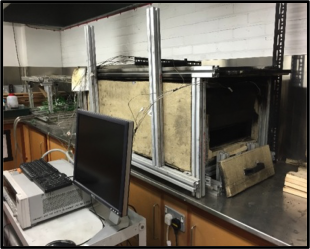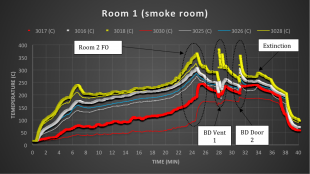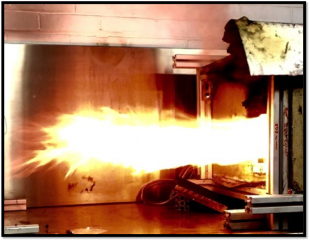Fires in basements and other restricted access / restricted ventilation spaces remain an unresolved problem for fire brigades. While some brigades have specific guidance in place regarding procedures for approaching and fighting such fires, this guidance is, for the most part, based on anecdotal evidence, having been instigated following incidents involving fire-fighter injuries or fatalities.
The first project adressing this issue aimed to provide further scientific understanding of under-ventilated fire dynamics in general, and the specific fire dynamics exhibited in basements when changes in ventilation conditions do occur.
The work was arranged in four overlapping work packages:
- The first package used an existing small-scale, cubic apparatus to investigate changes in fire behaviour with changes in ventilation.
- The second package investigated operational procedures, techniques and requirements with fire brigades.
- The third developed and used an elongated rectangular 'two room' apparatus to investigate fire behaviour in a more realistic, basement-like geometry.
- Finally, the last package developed operational guidance and disseminated information directly to various stakeholders, includign the Fire Brigade.
For WP3, a compartment with inner dimensions of 660 mm (W) x 450 mm (H) x 990 mm (L) and various ventilation openings was designed and built with the intent of simulating the basic conditions in a typical basement layout configuration and fire.
An experimental programme was designed and implemented to reveal which were the main conditions that triggered extreme fire behaviours, such as flashover and backdraught in the laboratory setup.
The project concluded that venting an under-ventilated fire via a single opening (e.g. through a ceiling opening or via a door to a second compartment) cannot be relied on as a safe practice for fire and rescue services to be used during fire-fighting.
Therefore, in situations where fire-fighters find a series of potential indicators or warning signs that indicate the possibility of extreme events like backdraught, the use of an offensive ventilation tactic such as a natural cross-flow approach appears to be a practical solution that minimises the likelihood and severity of any potential backdraught.
In situations where there is no physical way of opening a clear cross-flow path dilution (using water spray) appears as the only effective solution.
Investigation of the limits of applicability of water spray application is the goal of the second funded project.
The method of spraying water spray by the fire-fighters has proved very effective in reducing the average gas temperatures in small compartments, and in reducing the likelihood and severity of a backdraught provided that the dilution is sufficient. It is important that as little fresh oxygen as possible is introduced during the water spraying by the fire-fighters, and therefore it could be very beneficial to use tools such as piercing nozzles or cutting extinguishers if the building construction materials and layout allow for. This is intended for future study.
It is intended that these results, together with results from future linked projects, will be used to develop simple guidance, which may be used in fire brigade practice, to decide when and how to intervene in basements and other under-ventilated fires.




